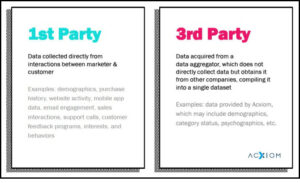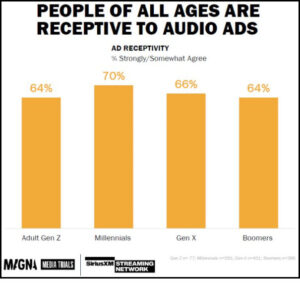Published on Inside Radio
Demographics have long been the guide posts for buyers as they approached audio advertising, and that remains the rule of thumb for broadcast radio. But as marketers approach digital audio, a new study finds that investment in first- and third-party data pays off in delivering a better return on their spending.
Magna, the media intelligence and investment arm of IPG Mediabrands, and SXM Media partnered on the study among music streamers. It identified and matched audience segments using first and third-party data from IPG’s Acxiom against roughly 12,000 data attributes – from behavioral to demographic – with a focus on a personalized experience. It then compared the results of those so-called “matched ads” to spots placed using just traditional demographic information such as age, gender, and income. The results show both additional data sources beat demographics alone.
First-party data delivered a 52% increase in aided ad recall while audiences bought using third-party data had a 42% increase in aided ad recall. That compared to a 34% increase for recall among music streamers targeted using traditional demographic parameters.
“This data shows that if brands are only leveraging demographic audiences in their digital audio buys, they are not leveraging the full power of digital audio and are leaving some effectiveness and cost efficiencies on the table,” says Kara Manatt, Executive VP of Intelligence Solutions at Magna.
The report says those matched audiences are also more cost effective at driving purchase intent. While demographic audiences have a $0.25 cost per person cost, it finds that those targeted using third-party data are much cheaper at a $0.09 cost per person.
Manatt says the research is not implying that demographic targeting doesn’t work, but rather that first- and third-party data can be used to sniff out audiences that can be even more impactful at driving metrics like recall and purchase intent. The study finds that those streaming listeners who were sourced that way had more than three-times greater impact on purchase intent. While demo-based buys had a 6% lift on purchase intent, the matched audiences delivered a 19% boost.
“We found that going beyond demographics alone yields stronger results across the key metrics that marketers care about, creating more memorable ad experiences and driving purchase intent,” says Melissa Paris, VP of Sales Research & Analytics, at SXM Media. “Reaching people based on demographics works. However, people are naturally more than their demographic profile, so when advanced data is used to identify those with a high propensity to buy, the impact on branding KPIs is greater.”

The research was done with clients in the audio and travel categories. While their identities are not being released, Magna and SXM Media say the ad creative was tailored to align with audience insights to highlight key product features that would be most relevant, or select a music bed or voiceover that would resonate with a brand’s intended audience.
“While the size of the impact differed, the patterns in the data were very similar for both auto and travel in that matched audiences consistently performed better,” Manatt says.
The customized message was not only useful to the brand, but also listeners as more than half said they found more personalized ads provided helpful information.
The matched audiences also helped sway those in the discovery phase. Brand favorability rose 13% with first- or third-party matched audience ads, compared to 1% gain for demo-based ads. The customized ads also had a 17% lift in users finding the brand “exciting” while the general market ad had 5% boost.
Regardless of how audiences are targeted, the study shows people of all ages are receptive to audio ads. About two-thirds of each age group say they are open to audio advertising, with Millennials the most receptive to the medium.
“We often find that it is more difficult to capture and hold the attention of younger generations, so it is very interesting to see all generations highly receptive to audio ads,” Manatt says.

The study focused on streaming music, and researchers are cautious about concluding the results would be the same for spoken word audiences.
“This would be a great next study,” Manatt says, “especially given how passionate we know listeners are about their podcasts.”

